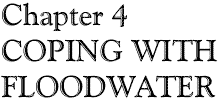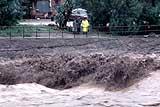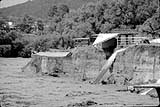
| ch. 4, pp. 35 - 36 |
What is a flood? According to Webster’s dictionary, a flood occurs when water overflows onto normally dry land. In this arid region the term often is used to describe a situation when an unusual amount of water flows in usually dry rivers, whether or not it overflows the banks. In Arizona an unusual amount of water flowing in a river with sufficient force to erode its banks is almost invariably referred to as a flood. Floods provide both benefits and problems. Floods can be beneficial when they recharge groundwater, but the same flow also can damage buildings and roads, erode land, and carry pollutants that may reach the groundwater. Years of bountiful rain and snow alternate with years of little precipitation. Heavy river flows occur occasionally and are essential for the growth of riparian vegetation. During flood years new cottonwood seedlings sprout and take hold. Traditional farming took advantage of the summer rainy season when water overflowed river banks bringing both moisture and nutrients to the soils. River flows replenished the groundwater table that remained near the surface. The water table was sufficiently high along most of the Santa Cruz River, from San Xavier to the Cañada del Oro, that cottonwood forests thrived. Such forests also were located along parts of the Rillito Creek, Tanque Verde Wash and Pantano Wash. A giant mesquite bosque flourished south of San Xavier. Changed river conditions have destroyed much of this riparian habitat, and developing new riparian habitat would be a difficult challenge, even using CAP water and effluent. Some even argue that conditions have deteriorated to the point that many riparian areas are beyond restoration. Construction along riverbanks and flood control structures have radically changed natural river conditions. Instead of meandering and spreading out onto floodplains to benefit riparian vegetation, floods now often are contained within deep channels.
The occurrence and intensity of flooding in southern Arizona appears to have increased during the last 30 years. While periodic changes in weather affect floods to a degree, human factors have played a greater role in determining flood damage. Floods that occur in wilderness areas are hardly noticed because humans usually are not affected. Floods that occur in urban areas, however, can affect large numbers of people and thus attract attention.
Urbanization is an important factor to consider when assessing the intensity of floods in Arizona. As Tucson has grown, much of the natural land surface of the area has been graded and covered with impervious surfaces — buildings, roads, sidewalks, parking lots, etc. — increasing runoff. In a natural desert environment only about three percent of the rainfall reaches the washes. In an urbanized area, about 18 percent of the rainfall flows to washes. The additional water in rivers and washes means that downstream flows increase in quantity and velocity. Channels enlarge, becoming deeper and wider, with erosion posing a greater threat. As Tucson urbanized, flooding became more menacing. Along their urban reaches, the Rillito Creek and Santa Cruz River have become deeply incised, with their channel bottoms as much as 40 feet below their banks. Waters no longer overflow the banks as they did when the rivers were shallow streams. Meanwhile homes and businesses have been constructed along river banks in the belief they are safe from floods. In reality, however, many areas become subject to bank erosion that can threaten structures. Soils that are dry most of the year quickly break up when water flows swiftly against them. Erosion is most likely to occur on bends in the river where water flows swiftly towards the bend, striking it with great force. In the 1983 flood, for example, bank erosion caused buildings to fall into the Santa Cruz River south of Ajo Way and into the Rillito Creek near First Avenue (See Figure 4-2). Some natural resource managers stress that floods, although now influenced by human activities, are natural and often beneficial occurrences, neither bad nor dangerous. Humans, however, have put themselves in harm’s way, by building on floodplains and encroaching on flood-prone areas. Floods then threaten human life and property and are perceived to be an intimidating menace to be confronted with administrative and technical ingenuity. In response, public officials devise and implement flood control measures to protect life and property. Measures that are adopted to control flooding, however, often have unintended consequences.
|


